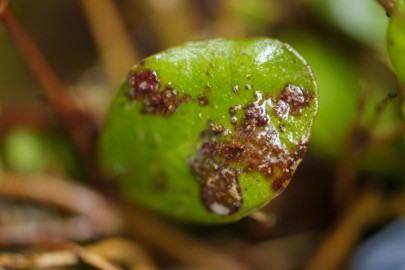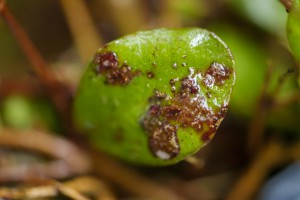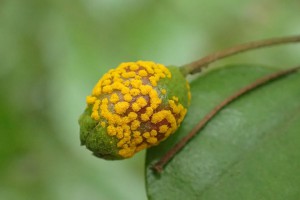
An active myrtle rust infection.
Myrtle rust was first detected in New Zealand in March 2017 and is now found throughout the upper North Island. It has currently been recorded as far south as Greymouth.
Manaaki Whenua is coordinating research activities on myrtle rust across New Zealand as part of the MBIE 5-year multi-institute research programme “Beyond Myrtle Rust” – to ensure an effective national response to the pathogen. These activities span four main research areas:
- Pathogen dynamics: Improving understanding of how the fungus reproduces in New Zealand.
- Ecosystem impacts: Investigating broad-scale impacts of Austropuccinia psidii on ecosystem functions, and assessing whether environmental factors (including host plant features) might influence disease progression and consequences.
- Novel mitigation techniques: Investigating host plant resistance to myrtle rust, whether plant or microbe-mediated.
- Kaitiakitanga and Māori-led solutions: Cultural and environmental priorities are being assessed alongside disease impacts, with capacity being built and management strategies developed, ultimately producing a Te Ao Māori values framework and protection plan.
Myrtaceae in New Zealand contribute to key ecosystem processes and services, either as early successional species (kānuka, mānuka, pōhutukawa), or as a long-term ‘climax’ vegetation canopy species (rātā). However, in many cases, we are still unsure of the degree to which ecosystem functions are dependent on Myrtaceae. By understanding what constitutes a healthy myrtaceous ecosystem (i.e. the baseline), Manaaki Whenua researchers can predict the effects of myrtle rust to better understand impacts on forest conservation efforts, and on ecosystem functions.
The programme, which began in October 2018, has made good headway despite the COVID lockdowns. At Manaaki Whenua, we have completed analyses quantifying the functional importance of Myrtaceae in New Zealand forests to compare species- and family-level richness and abundance patterns, functional attributes, and their environmental drivers. Initial results suggest Myrtaceae is the third most important woody-plant family in New Zealand.
Manaaki Whenua researchers are now set to head into the field this summer, when myrtle rust is most virulent. They will focus on disease dynamics in the hard-hit genus Lophomyrtus, and improve our understanding of ecosystem functions in native and naturally regenerating stands of mānuka. This will generate valuable baseline data in advance of possible disease development in this taonga species, enabling disease impacts and future management approaches to be better assessed.
Manaaki Whenua’s researchers are also involved in SSIF-funded work being run by the Biological Heritage National Science Challenge on kauri dieback and myrtle rust.


